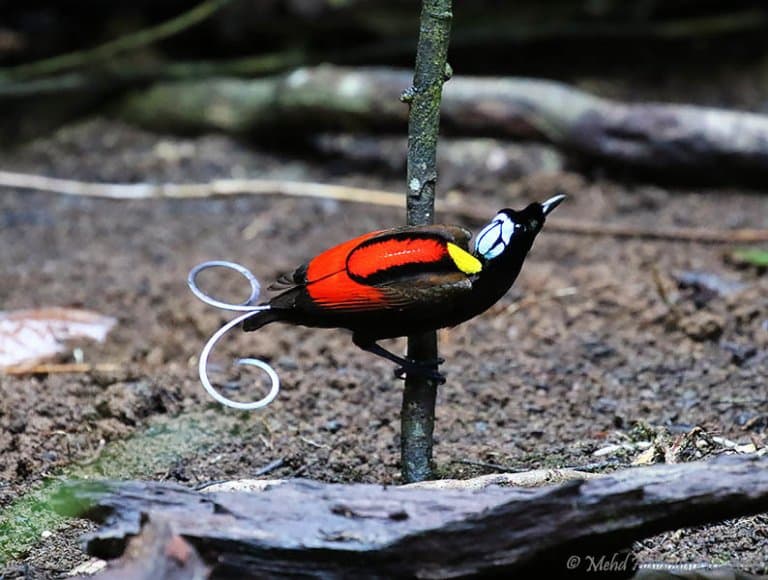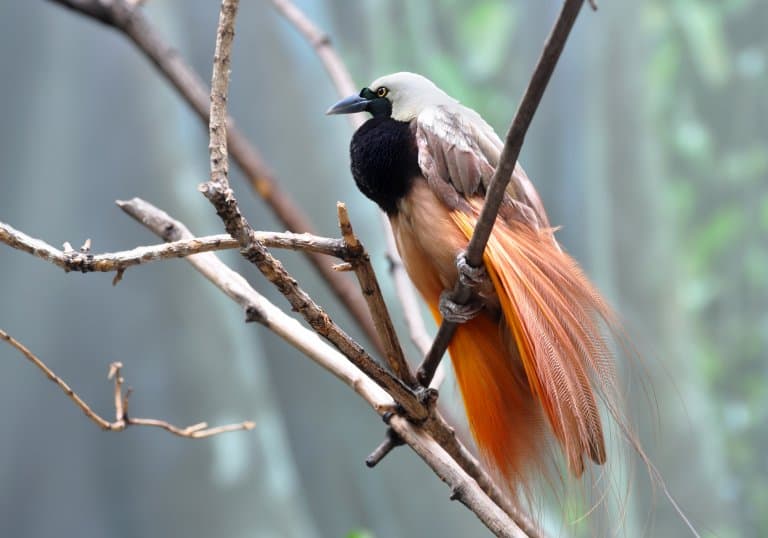Birds of Paradise Profile
The rainforests of Papua New Guinea conceal a wonderfully strange family of birds.
Each species is uniquely decorated, most with unbelievably bright, iridescent colours, and some with ornamental feathers so absurd that they look like childrens’ drawings brought to life.
On top of that, these birds perform some of the most complex, and often most ridiculous – courtship displays in the animal kingdom.
Birds of paradise belong to Paradisaeidae, a large and highly diverse family which contains 45 species within 17 genera. Their closest living relatives are the family Corvidae, which includes crows and jays.

Birds of Paradise Facts Overview
| Habitat: | Most species inhabit rainforest, moss forest, coastal mangroves, swamps, and temperate rainforest. |
| Location: | New Guinea, Maluku Islands and Australia |
| Lifespan: | Approximately 15 years |
| Size: | Species range from 15 to 50 centimetres (6 to 27 inches) in length |
| Weight: | Species range from 50 to 430 grams (1.8 to 15 ounces) in weight |
| Color: | Birds of paradise possess diverse and vivid colouration, and between all the species they exhibit virtually the entire colour spectrum. |
| Diet: | Fruit, invertebrates, nectar and occasionally small vertebrates |
| Predators: | Snakes and raptors |
| Top Speed: | 40 kph (22 mph) |
| No. of Species: |
45 |
| Conservation Status: |
Many species are listed as Vulnerable or Near Threatened by the IUCN 1 |
The vast majority of species within Paradisaeidae are endemic to Papua New Guinea, but species can also be found in eastern Indonesia and Australia, in various rainforest habitats.
Most birds-of-paradise species inhabit tropical forests, as well as swaps moss forests, and coastal mangroves.
They mainly diet on fruit and arthropods, but will also consume nectar and small insects. They are important for the ecosystem as seed dispersers for the forests in New Guinea.
Many species have very specific habitat requirements, for example cloud forest or mid-montane forest, which makes them particularly vulnerable to habitat loss and degradation.
Interesting Birds of Paradise Facts
1. Birds of paradise sport some of the most spectacular ornamentation in the animal kingdom
Birds or paradise are among the brightest- and often weirdest looking- birds in the world.
Their incredible variety of colours, shapes and wacky courtship behaviours is largely due to females being extremely picky about their mates, which results in intense competition between males to stand out from their peers.
2. Male birds of paradise are surviving on hard mode
The display feathers possessed by many male birds of paradise are often so large that they actually hinder the birds’ ability to fly. Alongside their bright colours, these ornaments make males much more vulnerable to predators than females.
By selecting only the most extravagant males, females ensure they have chosen a mate that is strong enough to survive despite his elaborate handicaps.
3. Birds of paradise take advantage of physics to produce their iridescent colours
The red, orange and yellow colours adorning the plumage of many birds of paradise are produced by special pigments which reflect those particular colours.
However, most blues, purples and greens, along with the otherworldly shimmering effects often exhibited in display plumage, are made by special microstructures within the feathers that refract and scatter light. 2

4. Despite the variation between species, hybridisation is surprisingly common amongst birds of paradise
The extreme mate selectivity of females is thought to be the main driving force behind the high diversity of the birds of paradise, but- somewhat paradoxically- different species appear to hybridise more often than most other birds.
They have even been found to hybridise between genera, suggesting that they are very closely related despite their physical differences.
5. Their courtship displays are highly ritualised and wonderfully weird
When it comes to winning a mate, just being colourful often doesn’t cut the mustard. Many male birds of paradise must perform elaborate courtship rituals to gain the approval of a female- these often involve complex dances and wacky sounds, all of which must be performed to perfection. 3 4
6. Some species have taken feather morphology a step further
While the majority of sounds produced by birds of paradise are made using their voices, a few species have evolved adaptations to supplement their vocal repertoire with percussion.
The riflebirds (genus Ptiloris), and the superb bird of paradise (Lophorina superba), use specially adapted feathers to create whooshing and snapping sounds during courtship displays 5 6
7. Not all birds of paradise follow the same reproductive pattern
Most birds of paradise exhibit extreme sexual dimorphism, where the male and female look dramatically different from each other. A few species, however, don’t follow this pattern.
The paradise-crows (genus Lycocorax), manucodes (genus Manucodia), and the paradigallas (genus Paradigalla) are sexually monomorphic.
8. Birds of paradise take a long time to reach maturity
It takes around 7 years for most male birds of paradise to acquire their full adult plumage. In their adolescence, they are drab brown and look similar to the females.
This allows them to reach adulthood without the extra threat of predation brought on by their spectacular adult ornamentation.

9. The traditional preparation of early specimens led to some crazy theories about them
The first bird of paradise specimens to be sent back to Europe were acquired from local traders who had removed their wings and feet for use as decorations.
Because of this, European taxonomists believed that birds of paradise never landed, instead being held inexplicably in the air by their elaborate feathers. 7
10. Their fantastic feathers are sought after by humans
Bird of paradise feathers are traditionally used by the people of New Guinea in traditional dress and rituals. In past centuries they also became popular for use in European clothing, and many species have become endangered as a result of hunting.
Habitat loss magnifies the impact of hunting, and currently represents the biggest threat to the survival of the birds of paradise.

11. Human admirers are helping to reduce the hunting of birds of paradise
Birds of paradise are a major attraction to New Guinea for birdwatchers and nature lovers.
The presence of tourists, and the money they bring to local economies, gives incentive to local people to preserve the habitat, and significantly reduces hunting as a result.
Birds of Paradise Fact-File Summary
Scientific Classification
| Kingdom: | Animalia |
| Phylum: | Chordata |
| Class: | Aves |
| Order: | Passeriformes |
| Superfamily: | Corvoidea |
| Family: | Paradisaeidae |
Fact Sources & References
- “IUCN Red List of Threathened Species”, IUCN Red List.
- Koch, A. (2018), “Discovery of a rare hybrid specimen known as Maria’s bird of paradise at the Staatliches Naturhistorisches Museum in Braunschweig.”, Zoosystematics and Evolution.
- (2013), “King-of-Saxony Bird-of-Paradise”, Youtube.
- Netflix (2019), “Our Planet -Birds Of Paradise”, Youtube.
- “Birds-of-Paradise Project”, The Cornell Lab.
- Cornell Lab of Ornithology (2013, “Sound: and the Birds-of-Paradise”, Youtube.
- Andaya, L.Y.(2017), “Flights of fancy: The bird of paradise and its cultural impact”, Cambridge University Press.
